- 16-cell
-
Regular hexadecachoron
(16-cell)
(4-orthoplex)
Schlegel diagram
(vertices and edges)Type Convex regular 4-polytope Schläfli symbol {3,3,4}
{3,31,1}
h{4,3,3}
s{2,2,2}Coxeter-Dynkin diagram 
































Cells 16 {3,3} 
Faces 32 {3} 
Edges 24 Vertices 8 Vertex figure 
OctahedronPetrie polygon octagon Coxeter group C4, [3,3,4]
D4, [31,1,1]
[23] (half)Symmetry group [3,3,4], order 384
[31,1,1], order 192
[3,4,2+], order 48
[23]+, order 8Dual Tesseract Properties convex, isogonal, isotoxal, isohedral Uniform index 12 In four dimensional geometry, a 16-cell or hexadecachoron is a regular convex 4-polytope. It is one of the six regular convex 4-polytopes first described by the Swiss mathematician Ludwig Schläfli in the mid-19th century.
It is a part of an infinite family of polytopes, called cross-polytopes or orthoplexes. The dual polytope is the tesseract (4-cube). Conway's name for a cross-polytope is orthoplex, for orthant complex.
Contents
Geometry
It is bounded by 16 cells, all of which are regular tetrahedra. It has 32 triangular faces, 24 edges, and 8 vertices. The 24 edges bound 6 squares lying in the 6 coordinate planes.
The eight vertices of the 16-cell are (±1, 0, 0, 0), (0, ±1, 0, 0), (0, 0, ±1, 0), (0, 0, 0, ±1). All vertices are connected by edges except opposite pairs.
The Schläfli symbol of the 16-cell is {3,3,4}. Its vertex figure is a regular octahedron. There are 8 tetrahedra, 12 triangles, and 6 edges meeting at every vertex. Its edge figure is a square. There are 4 tetrahedra and 4 triangles meeting at every edge.
There is a lower symmetry form of the 16-cell, called a demitesseract or 4-demicube, a member of the demihypercube family, and represented by h{4,3,3}, and Coxeter diagrams






 or
or 



 . It can be drawn bicolored with alternating tetrahedral cells.
. It can be drawn bicolored with alternating tetrahedral cells.It can also be seen in lower symmetry form as a tetrahedral antiprism, constructed by 2 parallel tetrahedra in dual configurations, connected by 8 (possibly elongated) tetrahedra. It is represented by h0,1{2,4,3}, and Coxeter diagram:






 .
.It can also be seen as a snub 4-orthotope, represented by s{2,2,2}, and Coxeter diagram:






 .
.Images

Stereographic projection
A 3D projection of a 16-cell performing a simple rotation.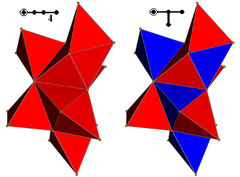
The 16-cell has two Wythoff constructions, a regular form and alternated form, shown here as nets, the second being represented by alternately two colors of tetrahedral cells.orthographic projections Coxeter plane B4 B3 / D4 / A2 B2 / D3 Graph 


Dihedral symmetry [8] [6] [4] Coxeter plane F4 A3 Graph 

Dihedral symmetry [12/3] [4] Orthogonal projection graphs 
demitesseract in order-4 Petrie polygon symmetry as an alternated tesseract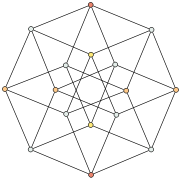
TesseractTessellations
One can tessellate 4-dimensional Euclidean space by regular 16-cells. This is called the hexadecachoric honeycomb and has Schläfli symbol {3,3,4,3}. The dual tessellation, icositetrachoric honeycomb, {3,4,3,3}, is made of by regular 24-cells. Together with the tesseractic honeycomb {4,3,3,4}, these are the only three regular tessellations of R4. Each 16-cell has 16 neighbors with which it shares an octahedron, 24 neighbors with which it shares only an edge, and 72 neighbors with which it shares only a single point. Twenty-four 16-cells meet at any given vertex in this tessellation.
Projections
The cell-first parallel projection of the 16-cell into 3-space has a cubical envelope. The closest and farthest cells are projected to inscribed tetrahedra within the cube, corresponding with the two possible ways to inscribe a regular tetrahedron in a cube. Surrounding each of these tetrahedra are 4 other (non-regular) tetrahedral volumes that are the images of the 4 surrounding tetrahedral cells, filling up the space between the inscribed tetrahedron and the cube. The remaining 6 cells are projected onto the square faces of the cube. In this projection of the 16-cell, all its edges lie on the faces of the cubical envelope.
The cell-first perspective projection of the 16-cell into 3-space has a triakis tetrahedral envelope. The layout of the cells within this envelope are analogous to that of the cell-first parallel projection.
The vertex-first parallel projection of the 16-cell into 3-space has an octahedral envelope. This octahedron can be divided into 8 tetrahedral volumes, by cutting along the coordinate planes. Each of these volumes is the image of a pair of cells in the 16-cell. The closest vertex of the 16-cell to the viewer projects onto the center of the octahedron.
Finally the edge-first parallel projection has a shortened octahedral envelope, and the face-first parallel projection has a hexagonal bipyramidal envelope.
4 sphere Venn Diagram
The usual projection of the 16-cell
 and 4 intersecting spheres (a Venn diagram of 4 sets) form topologically the same object in 3D-space:
and 4 intersecting spheres (a Venn diagram of 4 sets) form topologically the same object in 3D-space:

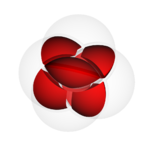
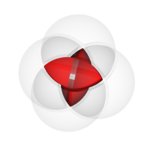
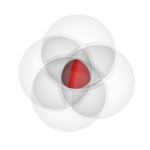
Related uniform polytopes
Name tesseract rectified
tesseracttruncated
tesseractcantellated
tesseractruncinated
tesseractbitruncated
tesseractcantitruncated
tesseractruncitruncated
tesseractomnitruncated
tesseractCoxeter-Dynkin
diagram






























































Schläfli
symbol{4,3,3} t1{4,3,3} t0,1{4,3,3} t0,2{4,3,3} t0,3{4,3,3} t1,2{4,3,3} t0,1,2{4,3,3} t0,1,3{4,3,3} t0,1,2,3{4,3,3} Schlegel
diagram








B4 Coxeter plane graph 








Name 16-cell rectified
16-celltruncated
16-cellcantellated
16-cellruncinated
16-cellbitruncated
16-cellcantitruncated
16-cellruncitruncated
16-cellomnitruncated
16-cellCoxeter-Dynkin
diagram






























































Schläfli
symbol{3,3,4} t1{3,3,4} t0,1{3,3,4} t0,2{3,3,4} t0,3{3,3,4} t1,2{3,3,4} t0,1,2{3,3,4} t0,1,3{3,3,4} t0,1,2,3{3,3,4} Schlegel
diagram








B4 Coxeter plane graph 








See also
Fundamental convex regular and uniform polytopes in dimensions 2–10 Family An BCn Dn E6 / E7 / E8 / F4 / G2 Hn Regular polygon Triangle Square Hexagon Pentagon Uniform polyhedron Tetrahedron Octahedron • Cube Demicube Dodecahedron • Icosahedron Uniform polychoron 5-cell 16-cell • Tesseract Demitesseract 24-cell 120-cell • 600-cell Uniform 5-polytope 5-simplex 5-orthoplex • 5-cube 5-demicube Uniform 6-polytope 6-simplex 6-orthoplex • 6-cube 6-demicube 122 • 221 Uniform 7-polytope 7-simplex 7-orthoplex • 7-cube 7-demicube 132 • 231 • 321 Uniform 8-polytope 8-simplex 8-orthoplex • 8-cube 8-demicube 142 • 241 • 421 Uniform 9-polytope 9-simplex 9-orthoplex • 9-cube 9-demicube Uniform 10-polytope 10-simplex 10-orthoplex • 10-cube 10-demicube n-polytopes n-simplex n-orthoplex • n-cube n-demicube 1k2 • 2k1 • k21 pentagonal polytope Topics: Polytope families • Regular polytope • List of regular polytopes References
- T. Gosset: On the Regular and Semi-Regular Figures in Space of n Dimensions, Messenger of Mathematics, Macmillan, 1900
- H.S.M. Coxeter:
- Coxeter, Regular Polytopes, (3rd edition, 1973), Dover edition, ISBN 0-486-61480-8, p.296, Table I (iii): Regular Polytopes, three regular polytopes in n-dimensions (n≥5)
- H.S.M. Coxeter, Regular Polytopes, 3rd Edition, Dover New York, 1973, p.296, Table I (iii): Regular Polytopes, three regular polytopes in n-dimensions (n≥5)
- Kaleidoscopes: Selected Writings of H.S.M. Coxeter, editied by F. Arthur Sherk, Peter McMullen, Anthony C. Thompson, Asia Ivic Weiss, Wiley-Interscience Publication, 1995, ISBN 978-0-471-01003-6 [1]
- (Paper 22) H.S.M. Coxeter, Regular and Semi Regular Polytopes I, [Math. Zeit. 46 (1940) 380-407, MR 2,10]
- (Paper 23) H.S.M. Coxeter, Regular and Semi-Regular Polytopes II, [Math. Zeit. 188 (1985) 559-591]
- (Paper 24) H.S.M. Coxeter, Regular and Semi-Regular Polytopes III, [Math. Zeit. 200 (1988) 3-45]
- John H. Conway, Heidi Burgiel, Chaim Goodman-Strass, The Symmetries of Things 2008, ISBN 978-1-56881-220-5 (Chapter 26. pp. 409: Hemicubes: 1n1)
- Norman Johnson Uniform Polytopes, Manuscript (1991)
- N.W. Johnson: The Theory of Uniform Polytopes and Honeycombs, Ph.D. (1966)
External links
- Weisstein, Eric W., "16-Cell" from MathWorld.
- Olshevsky, George, Hexadecachoron at Glossary for Hyperspace.
- Der 16-Zeller (16-cell) Marco Möller's Regular polytopes in R4 (German)
- Description and diagrams of 16-cell projections
- Richard Klitzing, 4D uniform polytopes (polychora), x3o3o4o - hex
Categories:- Four-dimensional geometry
- Polychora
Wikimedia Foundation. 2010.

